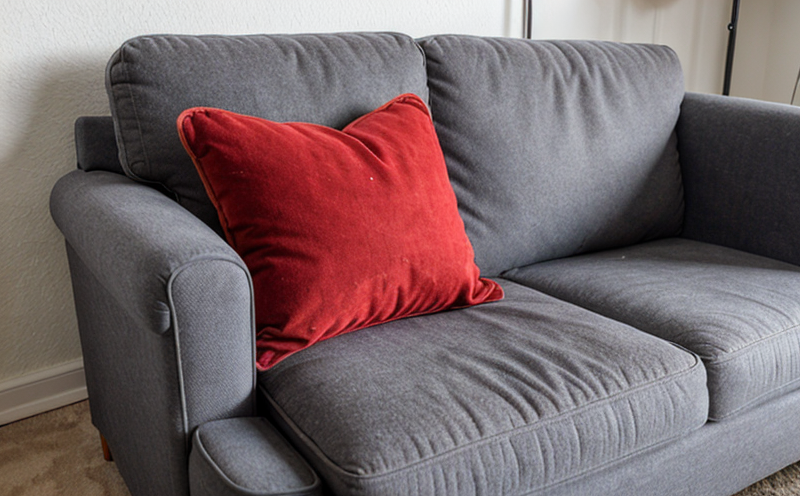ASTM D1683 Seam Strength Testing of Upholstery Cushions
The ASTM D1683 standard is a critical tool in ensuring the durability and reliability of upholstery cushions. This test measures seam strength by subjecting samples to uniaxial tensile loading until failure occurs. This procedure ensures that manufacturers can identify potential weaknesses in their products early on, thereby enhancing product quality and longevity.
The testing process involves several steps: first, the specimen is prepared according to ASTM D1683 specifications. The sample must be cut from a single piece of fabric or leather and include at least one seam per sample. After preparation, the specimen undergoes mechanical testing using an appropriate tensile tester capable of applying uniaxial tension.
The results are reported as the maximum load required to cause failure along with any relevant data such as elongation at break. Compliance with ASTM D1683 helps manufacturers meet industry standards and ensures consistent quality across products. By adhering to this standard, furniture makers can demonstrate their commitment to producing high-quality seating solutions that withstand everyday use.
This test plays a crucial role in the furniture manufacturing process by providing valuable insights into the structural integrity of cushion seams. It allows companies to optimize design parameters such as thread count and fabric type for improved performance. Additionally, ASTM D1683 helps ensure compliance with relevant regulatory requirements, which is essential for maintaining market access.
Understanding how different factors affect seam strength can significantly improve product design. For instance, certain fabrics may require additional reinforcement due to their inherent properties or environmental conditions under which they will be used. Knowledge gained from ASTM D1683 testing enables manufacturers to make informed decisions about material selection and construction methods.
In summary, ASTM D1683 seam strength testing is an essential practice in the upholstery industry that contributes directly to product quality and durability. It provides actionable data for designers and engineers working on improving existing models or developing new ones. Through rigorous application of this standard, manufacturers can build confidence among consumers regarding their products' reliability and longevity.
Why It Matters
The importance of ASTM D1683 cannot be overstated when it comes to ensuring the integrity of upholstery cushions. By conducting seam strength tests according to this standard, manufacturers can identify potential flaws early in the production process. This proactive approach not only enhances product quality but also reduces costly recalls later down the line.
- Identifies weak points in design or manufacturing processes
- Promotes consistent performance across all products within a range
- Aids in meeting regulatory requirements and maintaining market access
- Enhances customer satisfaction through superior product durability
Compliance with ASTM D1683 also demonstrates a company's commitment to quality assurance, which is increasingly important for building trust with consumers. In today’s competitive marketplace, having robust testing procedures in place can set your brand apart from competitors and contribute positively to brand reputation.
Why Choose This Test
Selecting ASTM D1683 seam strength testing offers numerous benefits for those involved in the furniture industry. Firstly, it provides valuable insight into the structural integrity of cushion seams, allowing manufacturers to fine-tune their designs and improve overall product quality.
- Identifies potential areas requiring reinforcement
- Promotes consistent performance across all products within a range
- Aids in meeting regulatory requirements and maintaining market access
- Enhances customer satisfaction through superior product durability
Secondly, this type of testing helps ensure compliance with international standards such as ASTM D1683 itself. This alignment not only simplifies regulatory processes but also opens up new markets for compliant products.
In addition to these practical advantages, choosing ASTM D1683 can help establish a reputation for quality and reliability among both customers and industry peers. By demonstrating your commitment to excellence in product development through rigorous testing protocols like those specified by ASTM D1683, you position yourself as a leader within the furniture sector.
Environmental and Sustainability Contributions
The adoption of ASTM D1683 seam strength testing can contribute positively to environmental sustainability efforts. By identifying weak points in cushion seams early on, manufacturers can reduce waste associated with failed products reaching consumers or end users. This reduces the need for rework, thereby conserving resources and minimizing energy consumption during production processes.
Furthermore, compliant products that pass ASTM D1683 testing tend to last longer than non-compliant alternatives. Longer-lasting furniture means less frequent replacements, which ultimately leads to reduced landfill waste and lower carbon footprints associated with manufacturing new items.
- Reduces resource consumption by minimizing rework
- Promotes product longevity leading to fewer replacements
- Makes a positive contribution towards reducing landfill waste
- Lowers overall environmental impact through optimized production practices
By incorporating ASTM D1683 seam strength testing into their quality assurance programs, manufacturers can take proactive steps toward sustainability. This approach aligns with broader corporate social responsibility goals while delivering tangible benefits to both the environment and business operations.





